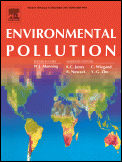Environmental Pollution 169
Overview of new articles on POPs in a new issue of the Environmental Pollution journal.

Pages 20-26
Huayun Yang, Shanshan Zhuo, Bin Xue, Chunlong Zhang, Weiping Liu
- PCBs residues remained widespread in Yangtze River Delta and adjacent East China Sea.
- Highest PCBs concentrations situate within the river-sea boundary zone.
- Congener profiles and PCA highlight the influence of e-waste recycling.
- Temporal distributions indicated PCB fluxes reached a maximum in this century.
- Total sediment burdens accounts for 1.9 % of all the PCBs in China.
Pages 90-97
Yücel Tasdemir, Güray Salihoglu, Nezih Kamil Salihoglu, Askın Birgül
- Seasonal PCB concentrations and fluxes at soil-air interface were assessed.
- Highest soil and air PCB concentrations occurred in summer and autumn.
- More soil-air exchange occurred in summer and autumn than in winter and spring.
- Flux levels of light congeners were higher than that of heavy congeners.
Atmospheric polybrominated diphenyl ethers (PBDEs) in the United Kingdom
Pages 105-111
Askin Birgul, Athanasios Katsoyiannis, Rosalinda Gioia, John Crosse, Mark Earnshaw, Nuno Ratola, Kevin C. Jones, Andrew J. Sweetman
- The occurrence of PBDEs has been studied in the atmosphere of four sites in the United Kingdom over a period of ten years.
- The concentrations have exhibited a sharp decrease after 2001–2003.
- The average ΣPBDE half-lives for these three sites were 3.4, 2.0 and 3.5 years respectively. ΣPBDEs concentrations in the UK (in 2010 ΣPBDEs < 10 pg m−3) are among the lowest reported in literature.
Pages 160-166
Junnan Ding, Junjun Zhong, Yifeng Yang, Bengang Li, Guofeng Shen, Yuhong Su, Chen Wang, Wei Li, Huizhong Shen, Bin Wang, Rong Wang, Ye Huang, Yanyan Zhang, Hongying Cao, Ying Zhu, Staci L.M. Simonich, Shu Tao
- Very high levels of parent PAHs, nitro-PAHs, and oxy-PAHs were detected in a rural non-smoking household in northern China.
- The PAHs measured in the bedroom air were primarily from the kitchen in the winter and from ambient air in the summer.
- The nPAHs were largely from secondary formation in ambient air, while oPAHs were either from primary emission of biomass burning or secondary formation.
- The daily mean benzo(a)pyrene equivalent exposure concentration was as high as 200 ± 160 ng/m3in the winter for the cooking housewife
Legacy and current-use flame retardants in house dust from Vancouver, Canada
Pages 175-182
Mahiba Shoeib, Tom Harner, Glenys M. Webster, Ed Sverko, Yu Cheng
- PBDE and new flame retardants are measured in 116 dust samples from Vancouver.
- House dusts are dominated by BDE-209.
- Nine of the non-PBDE flame retardants are detected with high frequency.
- Human exposure to FRs is evaluated.
Pages 190-195
Su-Hong Pan, Jun Li, Tian Lin, Gan Zhang, Xiang-Dong Li, Hua Yin
- Organic films on indoor and outdoor window surfaces in Guangzhou and Hong Kong were investigated.
- The dominant PAHs included phenanthrene, fluorene, fluoranthene, and pyrene.
- Total PAH concentrations on exterior films were higher than those on interior films.
- Heavy-weight PAHs on window surfaces showed a near-linear accumulation pattern.
Pages 196-203
Claudia E. Müller, Andreas C. Gerecke, Christian Bogdal, Zhanyun Wang, Martin Scheringer, Konrad Hungerbühler
- Atmospheric PFAS concentrations in Zurich increase during the night.
- Diel concentration dynamics are likely due to stable nocturnal boundary layer.
- City is a source of PFASs to the atmosphere.
- 8:2 FTOH concentrations are high: up to 1200 pg/m3.
- PFAA concentrations are correlated with ozone, not particulate matter.
Pages 204-209
Zhanyun Wang, Martin Scheringer, Matthew MacLeod, Christian Bogdal, Claudia E. Müller, Andreas C. Gerecke, Konrad Hungerbühler
- Diffusive emission strengths of four semi-volatile PFASs in Zurich are estimated.
- The boundary layer dynamics drives the day–night cycle of airborne PFASs in Zurich.
- Estimated emissions of 8:2 and 10:2 FTOH in 2010 agree well with earlier estimates.
- Emissions of MeFOSA and EtFOSA are low, but still ongoing.
Influence of sugarcane burning on indoor/outdoor PAH air pollution in Brazil
Pages 210-216
Joyce Cristale, Flávio Soares Silva, Guilherme Julião Zocolo, Mary Rosa Rodrigues Marchi
- In Brazil, sugarcane burning has been identified as a source of PAHs in indoor air.
- Outdoor and indoor PAH air profiles are similar during the sugarcane harvesting season.
- ∑PAH was about ten times higher during the harvest versus the non-harvesting season.
- An increase of cancer risk for people living in residences affected by sugarcane burning pollution was suggested.
Pages 217-229
Athanasios Besis, Constantini Samara
- PBDEs have been recognized as significant pollutants of the indoor environment.
- This article provides a synthesis and critical evaluation of the state of the knowledge about the occurrence of PBDEs in the indoor environment (air and dust in homes, workplaces and cars) in different countries in Europe, North America, Asia and Australia.
Estimation of human body concentrations of DDT from indoor residual spraying for malaria control
Pages 235-241
Tenzing Gyalpo, Lukas Fritsche, Henk Bouwman, Riana Bornman, Martin Scheringer, Konrad Hungerbühler
- Comparison of one-compartment pharmacokinetic model with biomonitoring data.
- Pre- and postnatal exposure of infants depends on breastfeeding duration and parity.
- Dietary exposure of DDT is the dominant uptake route in South Africa.
- Elimination half-lives of DDT and DDE are shorter in children than in adults.
The contribution of waste water treatment plants to PBDEs in ambient air
Pages 242-247
Tania Martellini, Kevin C. Jones, Andy Sweetman, Martina Giannoni, Francesca Pieri, Alessandra Cincinelli
- Levels and distribution profiles of PBDEs in the atmosphere surrounding two WWTPs.
- Airborne polybrominated diphenyl ethers in the surrounding area of two WWTPs in Italy.
- To investigate WWTPs as sources of PBDEs to the atmosphere.
- Samples collected downwind respect to the plant showed BDE-209 as dominant congener.
- The effect of distance and wind direction on atmospheric concentrations was also investigated.
16.7.2012




